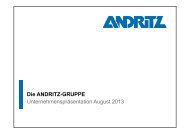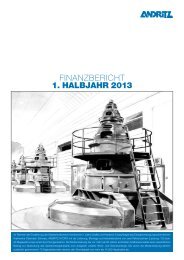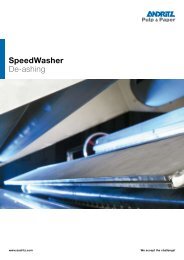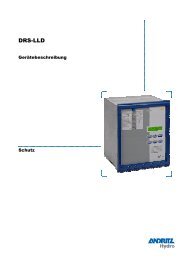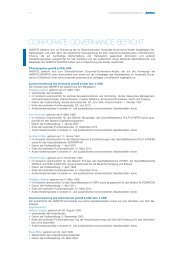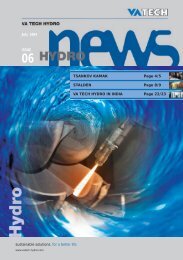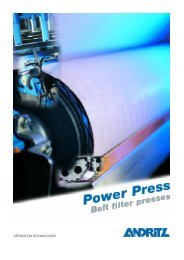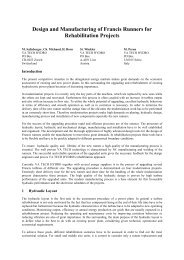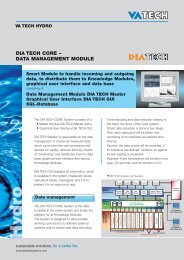2004 - ANDRITZ Vertical volute pumps
2004 - ANDRITZ Vertical volute pumps
2004 - ANDRITZ Vertical volute pumps
You also want an ePaper? Increase the reach of your titles
YUMPU automatically turns print PDFs into web optimized ePapers that Google loves.
120<br />
TECHNICAL GLOSSARY<br />
TECHNICAL<br />
GLOSSARY<br />
Air-dried pulp<br />
Pulp is described technically as air-dried when<br />
its moisture content is in equilibrium with the ambient<br />
atmosphere. Commercially, pulp is usually<br />
described as air-dried when the moisture content<br />
of the pulp is 10%.<br />
Annealing<br />
Process in which metal is heated, retained at a<br />
suitable temperature, then cooled rapidly or slowly<br />
to reduce internal stress. As a result, the metal<br />
becomes softer and more workable, particularly in<br />
cold processes.<br />
APMP/P-RC<br />
Alkaline Peroxide Mechanical Pulping is a refining<br />
process preceded by multi-stage impregnation<br />
with alkaline peroxide bleach liquors. The wood<br />
chips are compressed and destructured prior to<br />
addition of the bleach liquors. APMP systems can<br />
operate without a post bleach plant since bleaching<br />
takes place up front in the process. P-RC<br />
APMP is a technology that distributes chemicals<br />
between the impregnation steps and a small interstage<br />
bleach tower located between the primary<br />
and secondary refining stages. “P-RC” stands for<br />
Preconditioning-Refiner Chemical.<br />
BCTMP<br />
Bleached Chemi-Thermo Mechanical Pulping.<br />
The prefix “B” indicates that a post bleach plant,<br />
most commonly alkaline peroxide, follows the<br />
CTMP pulping step.<br />
Black liquor<br />
Mixture of spent cooking chemicals and dissolved<br />
wood material remaining after sulphate cooking.<br />
Black liquor is recovered during pulp washing,<br />
concentrated by evaporation, and burned in the<br />
recovery boiler to regenerate the cooking chemicals<br />
and also produce energy for the mill.<br />
Brownstock<br />
The pulp obtained directly from the cooking<br />
process, before intercellular materials and cooking<br />
liquors have been removed.<br />
Cellulose<br />
The primary constituent of pulp. Chemically,<br />
cellulose is a long-chained carbohydrate consisting<br />
of repeating chains of a single simple sugar,<br />
glucose.<br />
<strong>ANDRITZ</strong> <strong>2004</strong><br />
Chemical pulp<br />
A generic term which describes pulp produced<br />
by chemical (as opposed to mechanical) processes.<br />
These chemical processes include kraft<br />
(sulphate) and sulphite processes.<br />
Chemical recovery<br />
In chemical pulping, the collection, recovery, and<br />
regeneration of cooking chemicals so that they can<br />
be utilized again in the process.<br />
Chipping<br />
A process in a woodroom area in which the<br />
debarked logs are converted into chips for pulping<br />
or refining processes. Chipping is typically done<br />
by horizontally or gravity-fed disc chippers.<br />
CrescentFormer<br />
Sheet forming section in a tissue machine, with<br />
the pulp suspension jet-out of the headbox flowing<br />
between a felt and a wire both moving at the<br />
same speed.<br />
CTMP<br />
Chemi-Thermo Mechanical Pulping is a pressurized<br />
refining process which is preceded by the<br />
addition of sulphite in a single impregnation stage.<br />
The refining pressure for CTMP is usually lower<br />
than for TMP since the sulphite treatment lowers<br />
the softening temperature of the wood lignin. By<br />
altering the parameters of the process (chemical<br />
concentration, temperature, etc.) it is possible to<br />
customize the pulp for particular end uses. CTMP<br />
may be bleached, in which case it is known as<br />
BCTMP.<br />
Deinking<br />
A process in which most of the ink, filler, and<br />
other extraneous material is removed from printed<br />
and/or unprinted recovered paper. The result is a<br />
pulp which can be used in the manufacture of new<br />
paper, including tissue, printing, writing, and office<br />
papers.<br />
Delignification<br />
Removal of lignin from wood fibers (cellulose<br />
and hemi-cellulose). This is performed primarily in<br />
the cooking process and further carried out in the<br />
washing and bleaching process. In bleaching, ECF<br />
pulp mills use chlorine compounds (chlorine dioxide)<br />
for this process, although it can be achieved<br />
with oxygen, hydrogen peroxide, or ozone (which<br />
do not create organochlorines).






